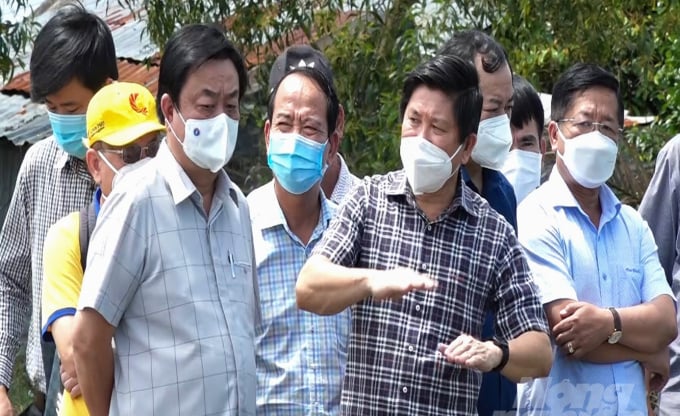November 25, 2025 | 18:47 GMT +7
November 25, 2025 | 18:47 GMT +7
Hotline: 0913.378.918
November 25, 2025 | 18:47 GMT +7
Hotline: 0913.378.918
Recently, Mr. Le Van Quang, General Director of Minh Phu Seafood Corporation (MPC), has proposed to Chairman of the National Assembly Vuong Dinh Hue on the construction planning of six sub-zones for Mekong Delta.
According to Mr. Quang, the MPC with its closed value model for the whole shrimp production chain, currently has 18 member companies including one in the US and another in Tokyo (Japan), with over 15,000 staff throughout the coastal provinces from Ninh Thuan to Ha Tien and Kien Giang.

Minh Phu Seafood Corporation representatives and a delegation from the Ministry of Agriculture and Rural Development led by Minister Le Minh Hoan survey a shrimp-rice growing model in Ca Mau at the end of September 2021. Photo: Trong Linh.
Mr. Quang assessed: “The Mekong Delta, with its diverse ecosystems, has a great potential for developing organic black tiger shrimp breeding as well as high-tech super-intensive shrimp farming. In addition, the Mekong Delta is a granary of rice and shrimp thus it has also a huge potential to increase its value to 20 times over the current figure with high competitiveness and high profits. However, the Mekong Delta needs to be planned properly and well, in the direction of 'favor of nature", adapting to climate change and sustainable development."
Accordingly, the MPC proposes to build six sub-zones as follow:
One is to focus on construction planning of marine urban regions with seaports and residential areas associated with boat berths and industrial zones favorable for processing fish and seafood products.
The second is to develop mangrove forests for raising shrimp, crabs and fish under the forest canopy so that to create a strip of mangrove forest 1-2 km wide running from Ha Tien to Vung Tau.
The third is to plan large enough high-tech super-intensive shrimp farming areas with the application of IoT and AI technologies to create high productivity and efficiency.

Mr. Le Van Quang assesses the potential of shrimp - rice farming in Mekong Delta is very large. Photo: LHV.
The fourth is to plan extensive shrimp farming areas large enough to create a biosecurity belt that will protect shrimp from infection of diseases and help achieve high survival rates and high profits.
The fifth is to plan concentrated shrimp processing and ancillary industrial zones associated with urban areas located in the center (to recruit workers for factories) and no more than five hours travelling by car from the material areas (to reduce the cost of salt storing, transportation and especially ensuring a good quality for the shrimp).
The sixth is to plan the shrimp-rice area large enough to create a bio-safety belt so that shrimp pathogens cannot penetrate the shrimp ponds. There, a concentrated residential area is separated from shrimp-rice farming, with freshwater reservoirs large enough to provide water for daily life and planting fruits.
According to Mr. Le Van Quang, with the above planning of six sub-zones, if it is carried out for each of coastal provinces in the Mekong Delta, with intra-regional and inter-regional transport connections, it will promote the advantages, specialty, and distinctiveness of each province. Planning zones can link cooperation, resonance to coordinate and increase the common strength.
Translated by Linh Nguyen
/2025/11/24/3536-2-112800_176.jpg)
(VAN) Dong Nai now has tens of thousands of hectares of forests certified for sustainable management, and this area will continue to be expanded in the coming period.

(VAN) Vinh Ha hamlet (Dai Xuyen commune, Hanoi) is shifting away from small-scale farming as households adopt bioscurity into their breeder chicken models.

(VAN) Heavy rains make aquatic species more vulnerable to disease. Proactive water management and high-tech systems help farmers prevent outbreaks and protect yields.

(VAN) Greenhouses are shifting production mindsets in Binh Lu commune, enabling farmers to ‘weather the sun and rain’ and secure stable vegetable harvests throughout the year.

(VAN) Green transition is crucial for the Mekong Delta amid climate change and stricter standards, offering a path toward sustainability.

(VAN) Dong Thap promotes agricultural restructuring, forms large specialized farming zones, raises the value of agricultural products and develops toward ecological and high-tech directions.
/2025/11/22/4018-4-213342_747.jpg)
(VAN) The Mekong Delta Agricultural Experts Club has attracted 143 experts and researchers to participate in providing consultancy and contributing initiatives to the development of one million hectares of high-quality rice.